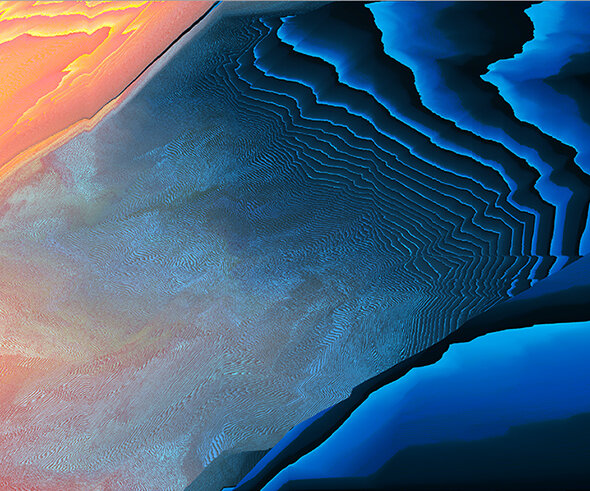JEFF THOMPSON: IMPOSSIBLE IN ANOTHER FORM
/JEFF THOMPSON: IMPOSSIBLE IN ANOTHER FORM
Gillespie Gallery
August 25 – September 19, 2014
Jeff Thompson’s divergent spin on data visualization uses computer programming technologies, video projection, and other digital media to create poetic and critical artworks with information mined from myriad digital devices, coding structures, and data streams. Although based in the science and application of digital information analysis, Thompson’s work does not seek to prove hypotheses or provide answers to complex problems; instead it presents data as a raw artistic material capable of generating new visual forms and questioning the cultural value of digital information.
The exhibition includes a collection of Thompson’s recent projects including Every Possible Photograph (2013), Seam Sorting (2013), and Computer Clock Choir (2014).
Every Possible Photograph (2013) investigates the idea of using computation to “use up” a piece of technology, in this case a digital camera. Using custom-written software (and a very long period of time), every possible photograph is generated, one at a time and in numerical order. Though limited to eight colors at a very low resolution, the piece will take approximately 46,138,562,195,008,110,600,774,753,760,087,749,172,181,189,607,929,628,058,548,517,099,604,563,033,706,075 years to complete (assuming the computer runs flawlessly 24-hours a day). By way of comparison, the universe is about 13,770,000,000 years old. The piece offsets these combinations starting at Niepce’s famous 1826 photograph looking outs his window, the first photographic image to be permanently captured. The idea that extremely useless labor is interesting is central to this project, as is the eschewing of the utility of data and its representation in traditional visualization work. Attempting to create every image a camera is essentially a time machine; somewhere in the set of images and alongside billions of “meaningless” others are a photograph of me, a photograph of me if I didn’t get a haircut last week, and a photograph of me with someone who I have never met. Additionally, this project interrogates the meaning of the camera. If the camera didn’t ‘see’ those events, are they real? They look like real people, but aren’t. Consider images created this way that are illegal (child pornography, for example): they are not ‘real’ but depict something very real.
Seam Sorting (2013) Uses a modified version of Photoshop’s “content-aware scaling” algorithm, called “seam carving”, to map a line of least energy through a found image (downloaded from Google) from bottom-center to the top. This line of pixels is gathered, sorted by color, and put back in place in the new sorted order. This line is then shifted one pixel to the right and the process repeated across the entire image. This process is accomplished with custom software, which then saves the image, rotates it 90°, and repeats the procedure several times, creating the taffy-like twisting and strange, emergent forms. Hundreds of source images were found and downloaded via an automatic Google image search. The exact images are irrelevant: results that are interesting are kept, those that are not are deleted (images of deserts, mountains, and sunsets seem to work quite well as source material). The sorted images retain the exact pixel data of the original, simply reorganized like milk stirred into coffee. The images are printed at large scale so that individual pixels can be seen, a remnant of their previous state.
Computer Clock Choir (2014) is a sound producing sculpture which deploys speakers from every computer the artist has owned or used regularly, each playing a square-wave at the frequency of their processor’s internal clock, scaled between the average resting human heart-rate and A440. The speakers are hung at average ear level and 7″ apart (average distance between a human’s ears).
About the Artist:
Thompson has exhibited internationally at venues including the Sheldon Museum of Art, the Taubman Museum of Art, SITE Santa Fe, Bemis Center for Contemporary Art, the Jersey City Museum, and the Weisman Art Museum. Recent commissions include Rhizome, Turbulence, and a project on haptic and non-visual videogames from Harvestworks. He has presented his projects at the CAA, FATE, and SECAC conferences, as well as a talk for TEDx. In addition to his studio practice, Thompson is an active curator, mounting exhibitions with the Bemis Center for Contemporary Art and Art MicroPatronage, as well as through Drift Station, a curatorial collaboration that mounts international, experimental exhibitions. He is currently an Assistant Professor and Program Director of Visual Art and Technology at the Stevens Institute of Technology in New Jersey.
For more information visit: http://www.jeffreythompson.org/
Exhibition Curator: Kariann Fuqua



